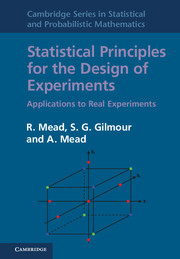Book contents
- Frontmatter
- Contents
- Preface
- Part I Overture
- 1 Introduction
- 2 Elementary ideas of blocking: the randomised complete block design
- 3 Elementary ideas of treatment structure
- 4 General principles of linear models for the analysis of experimental data
- Part II First subject
- Part III Second subject
- Part IV Coda
- References
- Index
2 - Elementary ideas of blocking: the randomised complete block design
from Part I - Overture
Published online by Cambridge University Press: 05 November 2012
- Frontmatter
- Contents
- Preface
- Part I Overture
- 1 Introduction
- 2 Elementary ideas of blocking: the randomised complete block design
- 3 Elementary ideas of treatment structure
- 4 General principles of linear models for the analysis of experimental data
- Part II First subject
- Part III Second subject
- Part IV Coda
- References
- Index
Summary
Controlling variation between experimental units
In an experiment to compare different treatments, each treatment must be applied to several different units. This is because the responses from different units vary, even if the units are treated identically. If each treatment is only applied to a single unit, the results will be ambiguous – we will not be able to distinguish whether a difference in the responses from two units is caused by the different treatments, or is simply due to the inherent differences between the units.
The simplest experimental design to compare t treatments is that in which treatment 1 is applied to n1 units, treatment 2 to n2 units,… and treatment t to nt units. In many experiments the numbers of units per treatment, n1, n2, …, nt, will be equal, but this is not necessary, or even always desirable. Some treatments may be of greater importance than others, in which case more information will be needed about them, and this will be achieved by increasing the replication for these treatments. This design, in which the only recognisable difference between units is the treatments which are applied to those units, is called a completely randomised design.
However, the ambiguity, when each treatment is only applied to a single unit, is not always removed by applying each treatment to multiple units. One treatment might be ‘lucky’ in the selection of units to which it is to be applied, and another might be ‘unlucky’.
- Type
- Chapter
- Information
- Statistical Principles for the Design of ExperimentsApplications to Real Experiments, pp. 9 - 28Publisher: Cambridge University PressPrint publication year: 2012



